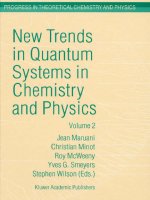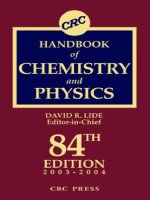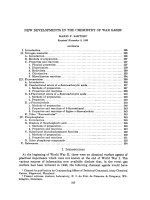New directions in antimatter chemistry and physics
Bạn đang xem bản rút gọn của tài liệu. Xem và tải ngay bản đầy đủ của tài liệu tại đây (13.57 MB, 524 trang )
NEW DIRECTIONS IN ANTIMATTER CHEMISTRY AND PHYSICS
This page intentionally left blank
New Directions in Antimatter
Chemistry and Physics
Edited by
Clifford M. Surko
Professor of Physics,
Physics Department,
University of California, San Diego,
U.S.A.
and
Franco A. Gianturco
Professor of Chemical Physics,
Dipartimento di Chimica,
Università di Roma “La Sapienza ”,
Rome, Italy
KLUWER ACADEMIC PUBLISHERS
NEW YORK, BOSTON, DORDRECHT, LONDON, MOSCOW
eBook ISBN:
Print ISBN:
0-306-47613-4
0-7923-7152-6
©2002 Kluwer Academic Publishers
New York, Boston, Dordrecht, London, Moscow
Print ©2001 Kluwer Academic Publishers
Dordrecht
All rights reserved
No part of this eBook may be reproduced or transmitted in any form or by any means, electronic,
mechanical, recording, or otherwise, without written consent from the Publisher
Created in the United States of America
Visit Kluwer Online at:
and Kluwer's eBookstore at:
Contents
ix
Preface
I.
Positron Sources and Beams
1.
A laser-cooled positron plasma
B. M. Jelenkovic, J. J. Bellinger, A. B. Newbury,
T. B. Mitchell and W. M. Itano
2.
3.
1
Trap-based positron beams
R. G. Greaves and C. M. Surko
21
Intense radioisotope sources for spin polarized positron beams
F. Saito, T. Hyodo, Y. Nagashima, T. Kurihara, N. Suzuki
Y. Itoh, and A. Goto
35
II.
Antihydrogen, Bose-Condensed Positronium, and Positrons
in Materials
4.
Collisions of H and
Alexander Dalgarno, Piotr Froelich, Svante Jonsell,
Alejandro Saenz, and Bernard Zygelman
47
Positron physics in a new perspective: Low-energy
antihydrogen scattering by simple atoms and molecules
E. A. G. Armour and C. W. Chamberlain
53
The Bose-Einstein condensation of positronium in submicron
cavities
D. B. Cassidy and J. A. Golovchenko
83
5.
6.
7.
8.
9.
Cooling and quenching of positronium in porous material
Haruo Saito and Toshio Hyodo
101
New experiments with bright positron and positronium beams
A. P. Mills, Jr. and P. M. Platzman
115
Positron states in materials: density functional and
quantum monte carlo studies
Bernardo Barbiellini
127
vi
10.
Depth-profiled positron annihilation spectroscopy of
thin insulating films
D. W. Gidley, K. G. Lynn, M. P. Petkov, M. H. Weber
J. N. Sun, and A. F. Yee
151
III.
Positron and Positronium Interactions with Atoms
11.
The scattering of positrons and positronium by atomic
targets
H. R. J. Walters, Jennifer E. Blackwood and Mary T.
McAlinden
173
Positronic atoms
J. Mitroy, M. W. J. Bromley and G. G. Ryzhikh
199
Perspectives on physics with low energy positrons:
fundamentals, beams and scattering
Michael Charlton
223
Positron chemistry by quantum monte carlo
Massimo Mella, Simone Chiesa, Dario Bressanini, and
Gabriele Morosi
235
Antimatter compounds
D. M. Schrader and J. Moxom
263
Positronium-atom/molecule interactions: momentum-transfer
cross sections and
Y. Nagashima, F. Saito, N. Shinohara, and T. Hyodo
291
Correlations between cross sections and threshold energies
for positronium formation and direct ionization
J. W. Humberston, P. Van Reeth and G. Laricchia
303
12.
13.
14.
15.
16.
17.
IV.
Positron and Positronium Interactions with Molecules
18.
Scattering of positronium atom off atomic hydrogen and
helium targets
A. S. Ghosh and Prabel K. Sinha
323
Atomic and molecular physics using positron traps and
trap-based beams
C. M. Surko
345
19.
vii
Contents
20.
21.
22.
23.
24.
25.
26.
Experimental studies of positron scattering using a weak
radioactive isotope source
O. Sueoka
367
Future opportunities in positron-atom (molecule) scattering
Stephen J. Buckman
391
Theory of positron annihilation on molecules
Gleb Gribakin
413
Bound states of positron with molecules
M. Tachikawa, I. Shimamura, R. J. Buenker and
M. Kimura
437
Low-energy positron dynamics in polyatomic gases
F. A. Gianturco, T. Mukherjee, T. Nishimura and
A. Occhigrossi
451
A test calculation on
of model potentials for correlation
and polarization effects in positron scattering from molecules
Robert R. Lucchese, F. A. Gianturco, P. Nichols, and
Thomas L. Gibson
475
On the contribution of polarization-correlation forces to
high annihilation rates in positron-molecule collisions
Márcio T. do N. Varella, Claudia R. C. de Carvalho
and Marco A. P. Lima
493
Author Index
503
Index
505
This page intentionally left blank
Preface
This volume is the outgrowth of a workshop held in October, 2000 at the
Institute for Theoretical Atomic and Molecular Physics at the HarvardSmithsonian Center for Astrophysics in Cambridge, MA. The aim of this
book (similar in theme to the workshop) is to present an overview of new
directions in antimatter physics and chemistry research. The emphasis is on
positron and positronium interactions both with themselves and with
ordinary matter. The timeliness of this subject comes from several
considerations. New concepts for intense positron sources and the
development of positron accumulators and trap-based positron beams
provide qualitatively new experimental capabilities. On the theoretical side,
the ability to model complex systems and complex processes has increased
dramatically in recent years, due in part to progress in computational
physics. There are presently an intriguing variety of phenomena that await
theoretical explanation. It is virtually assured that the new experimental
capabilities in this area will lead to a rapid expansion of this list.
This book is organized into four sections: The first section discusses
potential new experimental capabilities and the uses and the progress that
might be made with them. The second section discusses topics involving
antihydrogen and many-body phenomena, including Bose condensation of
positronium atoms and positron interactions with materials. The final two
sections treat a range of topics involving positron and positronium
interactions with atoms and molecules.
In the area of experimental capabilities, positron physics has historically
been hindered severely by the lack of intense, cold and bright positron
sources. One article in the first section presents a new design for an intense
source. Other articles in the same section describe new developments in the
use of Penning traps to create ultra-cold and intense, pulsed and continuous
positron beams.
These developments present qualitatively new
opportunities to study a range of phenomena ranging from fundamental
atomic and molecular physics to the characterization of materials and
material surfaces.
The articles in Section II on antihydrogen speak for themselves. There are
presently two experimental efforts at CERN to create and trap antihydrogen
atoms. If successful, this will represent the first stable antimatter in the
laboratory. It is quite likely that these efforts will blossom into several
important, long-term research directions. The two antihydrogen articles
discuss fundamental processes involving the interaction of these antiatoms
with ordinary matter. Not only is this an important theoretical question, but
it also has potentially important consequences for the development of
ix
x
practical schemes to cool antihydrogen sufficiently quickly to be able to trap
the atoms in present-day magnetic traps before they are lost to annihilation.
Another article in this section describes an experiment designed to create
Bose-condensed positronium. This is a very ambitious project, but one that
may now be feasible due, in part, to recent advances in positron traps and
beams. Even in lieu of the ultimate goal of producing Bose condensation,
this experimental research direction is likely to lead to other fascinating new
possibilities. These topics fall under the general category of positron-matter
interactions at high densities (e.g., the limit in which the de Broglie
wavelengths of the particles becomes comparable to the interparticle
spacing). Important questions in this regime include the formation of
molecules and the phase diagram of the correlated electron-positron gas in
the quantum regime (e.g., BEC positronium represents one phase in this
diagram). Other articles in Section II discuss the theoretical and practical
aspects of positron interactions in materials.
The last two sections in this volume describe positron interactions with
atoms and molecules. While this is a subject with a long history, a
surprisingly large number of fundamental questions remain to be
understood. This is due in large part to the fact that the experimental tools
that have been commonplace in studying ion, electron, photon, and neutral
atom interactions are only now becoming available to study the analogous
positron and positronium interactions. Many of the problems in this area
relate to low-energy interactions of positrons with matter and can be
considered to be fundamental to the establishment of a quantitative
antimatter-matter chemistry.
Section III focuses on phenomena involving atoms. One important question
regards the existence and nature of positron-atom bound states. Described
in this section are accurate calculations of the ground state energy levels of
these complexes. These calculations leave little question that such states do
exist. Thus the challenge in this area is now in the experimentalist's camp.
Other phenomena of interest include understanding the details of
positronium formation in positron-atom collisions and a variety of other
positron and positronium scattering processes, including the application of
recently developed experimental tools to study electronic excitations and
resonances in atoms.
Section IV focuses on positron and positronium interactions with molecules.
Presently there is keen interest in this area, driven by the recent advances in
both theory and experiment. Newly developed experimental techniques
have permitted the study of low-energy annihilation processes further
illuminating experimental findings, dating back three decades, that modest
changes in the chemical structure of molecules can result in orders of
Preface
xi
magnitude changes in the annihilation rate. While far from understood, this
and related phenomena have recently been analyzed by a number of
theoretical groups. Several possible mechanisms have been proposed and
are under active discussion. The quantitative predictions that are now
becoming available will undoubtedly stimulate a new round of experiments,
some of which are outlined in the experimental articles in this section.
Other topics of interest include understanding the dynamics of the postannihilation system including molecular fragmentation and the distribution
of final states.
The situation is more or less the reverse in the area of low-energy positron
scattering, where there have been a range of predictions for phenomena
involving molecules that remain still to be tested. New experimental
techniques appear to be on the verge of being able to study these aspects of
our understanding. This topic of positron-molecule scattering also relates
directly to the question of positron annihilation on molecules in the sense
that low energy scattering experiments can, in principle, measure the zeroenergy scattering length. In this way, one can obtain a quantitative measure
of the the low-energy positron-molecule interaction that, at least in some
theories, is predicted to give rise to positron bound states and virtual
resonances.
This volume contains many stimulating ideas that are likely to inspire new
research efforts into the chemistry and the physics of low-energy antimatter
and matter-antimatter interactions. It also presents an up-to-date picture of
the scientific landscape as viewed by the international community of
physicists and chemists, both experimentalists and theoreticians, who are
tackling the broad range of problems in this area. In closing, we wish to
thank the people responsible for this new look at the field. We are indebted
to Kate Kirby and members and staff of the Institute for Theoretical Atomic
and Molecular Physics at the Harvard-Smithsonian Center for Astrophysics
for hosting the workshop at which this project began to take shape. We
thank both the authors and reviewers of the articles in this volume for their
cooperation. Finally we thank Ms. Judy Winstead for her generous
involvement and the substantial amount of work required to successfully
merge the contributions from over twenty authors into the final manuscript
that produced this volume.
Cliff Surko
La Jolla
Franco Gianturco
Rome
This page intentionally left blank
Chapter 1
A LASER-COOLED POSITRON PLASMA
†
J. J. Bollinger, A. B. Newbury ,
T. B. Mitchell‡, and W. M. Itano
Time and Frequency Division, National Institute of Standards and Technology§
Boulder, CO
Abstract
1.
We present results on trapping and cooling of positrons in a Penning
trap. Positrons from a 2 mCi
source travel along the axis of a
6 T magnet and through the trap after which they strike a Cu reflection moderator crystal. Up to a few thousand positrons are trapped
and lose energy through Coulomb collisions (sympathetic cooling) with
laser-cooled
By imaging the
laser-induced fluorescence, we
observe centrifugal separation of the
ions and positrons, with the
positrons coalescing into a column along the trap axis. This indicates
the positrons have the same rotation frequency and comparable density
as the
ions, and places an upper limit of
approximately 5 K on the positron temperature of motion parallel to
the magnetic field. We estimate the number of trapped positrons from
the volume of this column and from the annihilation radiation when the
positrons are ejected from the trap. The measured positron lifetime is
> 8 days in our room temperature vacuum of
Pa.
INTRODUCTION
This paper presents experimental results on the capture, storage and
cooling of positrons in a Penning trap that simultaneously contains lasercooled
ions. The experimental work follows previous discussions
and simulations of trapping and sympathetic cooling of positrons via
Coulomb collisions with cold
ions [1,2]. Cold positron plasmas are
useful as a source for cold beams of high brightness [3, 4, 5, 6]. Many
of the chapters in this volume, for example the chapters by Greaves
* Also at Institute of Physics, University of Belgrade, Yugoslavia.
†
Permanent address:Ball Aerospace, Boulder, CO 80301
‡
Permanent address: Dept. Phys. and Astron., Univ. of Delaware, Newark, DE 19716
§
Contribution of the National Institute of Standards and Technology. Not subject to U.S.
copyright.
1
C.M. Surko and F.A. Gianturco (eds.),
New Directions in Antimatter Chemistry and Physics, 1–20 .
© 2001 Kluwer Academic Publishers. Printed in the Netherlands.
2
and Surko and by Surko, discuss applications of cold positron beams.
In addition cold positron plasmas are useful for studies of positronnormal-matter interactions, such as the study of resonances in lowenergy positron annihilation on molecules [3], for production of a plasma
whose modes must be treated quantum mechanically [1, 7, 8], and for
formation of antihydrogen by passing cold antiprotons through a reservoir of cold positrons [9, 10, 11].
Several groups have successfully trapped positrons in electromagnetic
traps. Positrons have been trapped using resistive cooling of the positrons
[12], by ramping the trap electrostatic potential [13], and in a magneticmirror configuration by electron cyclotron resonance heating [14]. Recent experiments by Gabrielse and co-workers [15, 16, 17] have successfully trapped more than
positrons in 17 hours through a method
where apparently positronium in a high Rydberg state created on the
surface of the moderator is field-ionized in the trap. They used a 3
mCi positron source and a tungsten positron moderator in the experiment. The positrons were cooled by thermalization with a cryogenic
Penning trap which ensured a temperature of ~4 K. Surko and coworkers [3, 5, 18, 19, 20], using a 90 mCi positron source, report the
largest number of trapped positrons
with a trapping rate
of
positrons in 8 minutes and a trapping efficiency greater than
25 % of the moderated positrons. The positrons were thermalized to
room temperature since the trapping was achieved through collisions
with a room-temperature buffer gas of
In this paper we will discuss the results of simultaneously trapping
and cooling positrons with laser-cooled
ions. We load positrons by
following the prescription of Gabrielse and coworkers [15, 16, 17] for fieldionizing high Rydberg positronium. We observe centrifugal separation of
the positrons and
ions, which enables us to determine the positron
density and place a rough upper bound on the positron temperature.
In Sec. 2 we describe the experiment, and in Sec. 3, the positron
detection methods. In Sec. 4 we present the measured accumulation
rates and positron lifetime. The discussion of our method for estimating
temperature limits is presented in Sec. 5. We conclude by summarizing
and discussing future possibilities.
2.
EXPERIMENTAL SETUP
The Penning trap, along with the positron source and positron moderator are shown in Fig. 1. The stack of cylindrical electrodes (60 mm
long) forms two Penning traps. The top (load) trap was used to create
plasmas by ionizing neutral Be atoms sublimated from a heated
A laser-cooled positron plasma
3
Be filament and directed through a small hole on the ring electrode. The
ions are transferred to the lower (experimental) trap for experimentation. In a single load-transfer cycle we can store over one million
ions. By repeating this procedure we can further increase the number of
ions. The inner diameter of the trap electrodes is 10 mm, and the traps
are enclosed in a glass cylinder that, after baking at ~350 °C, maintains
a vacuum better then
Pa. The magnetic field is
which
produces a cyclotron frequency for
ions of
The magnetic field is aligned to the trap symmetry axes to within 0.01°.
An axisymmetric, nearly quadratic trapping potential is generated by
biasing the ring of the experimental trap to a negative voltage
and
adjacent compensation electrodes to
For
and for the endcap voltage
the single particle axial frequency
is
and the magnetron frequency is
In Penning traps, the ion plasma undergoes an E×B drift and rotates
about the trap axis. This rotation through the magnetic field produces,
through the Lorentz force, the radial binding force and radial plasma
confinement. When a plasma reaches thermal equilibrium the whole
ion plasma rotates at a uniform rotation frequency
A two-fold azimuthally segmented electrode located between the ring and the lower
compensation electrode (not shown on Fig. 1), was used to generate an
oscillating electric-field perturbation by applying out-of-phase sinusoidal
potentials on its two segments. The oscillating field is the superposition
of components that rotate with and against the plasma rotation. The corotating component was used to control the plasma rotation frequency
(the “rotating wall”) [21, 22].
The ions were cooled by a laser beam tuned ~ 10 MHz lower than
a hyperfine-Zeeman component of the
resonance at
313 nm. The laser beam was directed through the trap, intersecting the
ion plasma on the side receding from the laser beam due to the plasma
rotation. As shown in Fig. 1 the beam entered the trap between the
upper compensation and ring electrodes, passed through the trap center,
and exited through the gap between the ring and lower compensation
electrode, making an 11° angle with the horizontal (x-y) plane. Based on
measurements performed in previous experiments [23, 24, 25] we expect
where
and
describe the velocity distributions
in the direction perpendicular and parallel to the trap axis ( axis).
An ion plasma in thermal equilibrium at these cryogenic temperatures
is a uniform-density plasma with a rigid-body rotation frequency
in
the range
The ion density is constant within the
plasma and is given by
where and are the
charge and mass of an ion, and is the permittivity of the vacuum. With
4
the quadratic trapping potential near trap center, the plasma has the
shape of a spheroid whose aspect ratio,
depends on
Here
and
are the axial and radial extents of the plasma. Low rotation
results in an oblate spheroid of large radius. Increasing
increases the Lorentz force due to the plasma rotation through the
magnetic field, which in turn increases and
At
(Brillouin
limit) the ion plasma attains its maximum aspect ratio and density. For
ions at 6 T the maximum ion density is
High
density can be reached by using torques produced by a cooling laser
beam [26] or by a rotating electric field perturbation [21, 22] to control
the plasma’s angular momentum. Typically, the ions were first Doppler
A laser-cooled positron plasma
5
laser-cooled and
was approximately set by the laser torque. The
“rotating wall” was then turned on at a frequency near the rotation
frequency of the
plasma. Resonantly scattered 313 nm photons
were collected by an f/5 imaging system in a direction 11° above the z = 0
plane of the trap and imaged onto the photocathode of a photon-counting
imaging detector. Such an optical system produces an approximate sideview image of the
plasma.
The source for the positrons is a 2 mCi
source with an active
diameter of ~1 mm. The source is placed just above the vacuum envelope, and positrons enter the trap through a Ti foil of
thickness.
Positrons travel along the axis of the Penning traps until they hit the
moderator crystal placed below the lower end-cap of the experimental
Penning trap. The positron current reaching the crystal was measured
by an electrometer. At the beginning of our experiment the measured
current was ~2 pA, in accordance with the expected positron losses in
the Ti foil and the fringing fields of the magnet at the position of the
source. A thin chopper wheel is placed between the
source
and the Ti foil for lock-in detection of the positron current (if needed)
and to temporary block the positrons from entering the trap without
removing the
source.
For the method of trapping positrons discussed in [2], a room temperature kinetic-energy distribution of moderated positrons is important.
Room-temperature distributions of moderated positrons have been reported in the literature for a number of single-crystal metallic moderators. We chose a Cu(111) moderator crystal because of the expected
narrow distribution of positrons [27, 28], and because it can be annealed
and cleaned at a lower temperature (~900 °C). The experimental results discussed here were obtained with the moderator crystal heated to
350 °C during the vacuum bakeout.
3.
POSITRON DETECTION
In the experiment, the presence of trapped positrons was verified by
three different methods. The positrons were detected by our a) observing changes in the
ion fluorescence due to application of the
microwaves near the positron cyclotron frequency, b) detecting the absence of
ions in the plasma center in side-view images of the
ion fluorescence, and c) detecting the annihilation radiation after pulsing the accumulated positrons onto the titanium foil (same foil that is
at the top of the vacuum envelope). Figure 2 is a schematic diagram of
the different detection techniques.
6
3.1.
Positron Cyclotron Excitation
The first evidence of positron trapping was obtained through microwave excitation of the positron cyclotron resonance near 166 GHz.
Waveguides carry the microwave radiation into the magnet bore close
to the trap center. The microwaves heated the positrons by increasing
their cyclotron energy. Through the Coulomb interaction the positrons
then increased the
ion energy which changed the level of the
ion resonance fluorescence.
A laser-cooled positron plasma
7
Figure 3 (a) shows a resonance curve of the detected fluorescence at
313 nm while the microwave frequency was stepped near the positron
cyclotron frequency. We believe the ~200 kHz resonance width was
probably caused by power broadening, because a significant positron excitation appeared to be required to observe the resonance. First, there
was a sharp threshold in the microwave power required to observe the resonance. Second, an increase of a few dB in the applied microwave power
above this threshold was sufficient to rapidly annihilate the positrons,
presumably through excitation of the positrons to a least a few volts energy where positronium formation with background gas atoms could take
place. The significant excitation of the positron cyclotron motion was
probably necessary because of the weak coupling between the positron
cyclotron and
ion motions, and the low rate of energy transfer
between the positron cyclotron and axial energies in the high magnetic
field of our trap [29]. Other potential sources of broadening include the
relativistic mass shift (~10 kHz for each 300 K in energy), first-order
Doppler broadening from positron motion within the trap, and magnetic
field instability and inhomogeneity. Sections 3.2 and 3.3 show that, when
cold, the positrons were typically confined in the Lamb-Dicke limit where
first-order Doppler broadening occurs as side-bands. We did not observe
any axial or rotational side-bands. Finally the measured magnetic field
instability
and inhomogeneity
were
too small to produce the observed broadening.
3.2.
Centrifugal Separation
Due to the plasma rotation, ion species with different charge-to-mass
ratios tend to centrifugally separate in a Penning trap [30, 31]. If ions
with different
rotate about the trap axis at the same radius, they
will tend to rotate with different rates because of different centrifugal
forces. Collisional drag will cause a radial drift of the lighter ions inward, and the heavier ions outward, if the ions have the same charge.
The different species will separate and the whole plasma will come to
thermal equilibrium and rotate at uniform
as a rigid body [31]. At
low temperatures the density inside either species is constant, and drops
to zero at the species boundaries within a distance on the order of the
temperature-dependent Debye length. Therefore, trapped positrons, if
cooled, will move to smaller radii than the
ions. In the limit of zero
temperature, the edges of each plasma will be sharp (Debye length 0),
and the plasmas will completely separate, with the positrons forming a
column of uniform density along the trap axis. If the
plasma density is significantly below the Brillouin limit, the
and
densities
8
are expected to be approximately equal and the plasma separation quite
small [7, 31].
Figure 4 shows an image of a
plasma along with the radial
dependence of the fluorescence signal. The
ion density
is calculated from the rotation frequency
set by the rotating wall. With
approximately equal density for both species, the number of positrons
in the “dark” column of the plasma image is
where V is the
volume of the “dark” region.
If any ions with a charge-to-mass ratio greater than
are created during the positron accumulation, they will also centrifugally separate and contribute to the size of the non-fluorescing column in the
plasma center. With the
source blocked, we deliberately created
singly charged light-mass ions by ionizing background gas with a ~15 eV
A laser-cooled positron plasma
9
electron beam. Prom the volume of the central dark region as a function of time, the lifetime of the light-mass ions was measured to be less
than 10 hours. Similar measurements were performed after accumulating positrons and are discussed in more detail in the next section. In
this case very little change in the volume of the central dark region was
observed after the
source was blocked for 12 hours. This indicates
that most of the dark central region in Fig. 4 is due to positrons rather
than impurity ions of light mass.
3.3.
Positron Annihilation
To further verify that the dark central column in Fig. 4 is due to
accumulated positrons, we pulsed the
plasma onto the
Ti foil located above the trap and detected the resulting positron annihilation radiation. With the energy (< 1 keV) that the positrons
acquire during the pulse, all of the positrons annihilate in the Ti foil.
10
The positron annihilation radiation was detected with a Nal scintillation crystal mounted 2.5 or 5 cm above the Ti foil. A light pipe coupled
the output of the Nal crystal to a photomultiplier tube mounted a few
feet above the magnet. (The
source is removed from the magnet
bore during this procedure.) In addition to detecting positrons that are
cooled and centrifugally separated from the laser cooled
ions, this
method is also sensitive to positrons that may be trapped but not cooled
to a point where they centrifugally separate from the
We attempted to eject all the positrons rapidly compared to the rise
time of the Nal crystal scintillation (~300 ns ). In this way the scintillation crystal will produce a single pulse, free from background radiation,
whose height is proportional to the number of annihilated positrons.
Positrons were pulsed with different sets of voltages on the trap electrodes and with different pulse voltages. For example, starting with the
plasma trapped with axially symmetric voltages on the experimental trap, the experimental and load trap voltages were adiabatically
changed so that the
plasma was moved to the region of the
lower endcap of the load trap, where it was confined by the following
electrode potentials: 900 V, 900 V, 900 V, 850 V, 800 V, 0 V, 250 V and
100 V. Here the potentials are listed starting with the lower endcap of
the experimental trap and moving up. The lower endcap of the load trap
was then pulsed from 0 V to 500 V by a voltage pulser with a ~50 ns
rise time. The resulting output pulse of the photomultiplier preamplifier
was recorded on a digital scope.
For a fixed procedure for positron ejection the voltage peak of the output pulse was proportional to the number of light-mass charge measured
from side-view images such as Fig. 4. However, changing the electrode
potentials and pulse voltages of this procedure produced, in many cases,
a different proportionality constant. For some conditions the output annihilation pulse was significantly longer than the scintillator single-event
pulse and delayed beyond the scintillator and high-voltage pulse risetimes. This indicated that for these conditions not all the positrons were
dumped simultaneously. We believe the reason for this is pick-up and
ringing induced by the high-voltage pulse on different trap electrodes.
While we could not detect ringing and pick-up sufficient to cause this
problem, we could monitor the trap potentials only outside the vacuum
system. Therefore, to estimate the number of trapped positrons, only
annihilation procedures that produced single-event pulses were used.
The Nal crystal detection system was calibrated with a ~37 kBq
source. This is a good source for calibration purposes because
it is principally a positron emitter (511 keV
) and relatively free
from other major photon emissions. One of the larger uncertainties in
A laser-cooled positron plasma
11
the calibration is due to the difference in the size of the
511 keV
source (
radius) and the annihilation spot on the Ti foil (<
1 mm). Overall we estimate the uncertainty in determining the number
of annihilated positrons from the peak of the preamplifier output pulse
to be ~25 %.
Figure 5 summarizes the results of a number of positron annihilations
done with several different experimental procedures. As discussed above,
only annihilation procedures which produced single-event pulses are plotted. Even with this requirement some systematic variation between the
different procedures is observed. While we do not understand this variation, the positron number determined by the annihilation method should
provide a lower limit for the number of trapped positrons. In all cases
the positron number measured by annihilaiton is greater than the number calculated from the volume of the “dark” column. However, the
~40 % difference is on the order of the combined uncertainty of these
two positron measurement methods. Therefore we cannot determine
with any certainty whether the number of trapped positrons is greater
than indicated by the volume of the “dark” column. However the annihilation measurements do support our claim that most of the light-mass
charges in images such as Fig. 4 are positrons that have centrifugally
separated from the
ions.
Centrifugal separation implies that the positrons are rotating with the
same rotation frequency as the
ions and are cold enough to have
approximately the same density. We observed centrifugal separation of
the positrons with rotation frequencies up to 1 MHz. For larger rotation
frequencies, the radius of the positron column was too small to clearly
see separation. In the 6 T magnetic field of this experiment
MHz gives positron densities
This is ~50 times greater
than the highest positron density previously achieved [20].
4.
POSITRON ACCUMULATION AND
LIFETIME
Because of method’s simplicity, we initially attempted to load positrons
by following, as much as possible, the method described in Ref. [17] of
field ionizing high-Rydberg positronium. We summarize here the accumulation rate obtained with this method. We also plan to accumulate
positrons by the method outlined in Ref. [2], where positrons are loaded
through Coulomb collisions with trapped
ions. Results of this
method will be discussed in a future publication.
The basic idea from Gabrielse’s group is that in high magnetic field
a fraction of the moderated positrons that leave the moderator crystal
12
combine with an electron to form positronium in a very high Rydberg
state at the moderator crystal’s surface. After leaving the crystal, the
positronium travels into the trap as long as the electric fields between
the moderator and trap are not large enough to field-ionize the Rydberg
state. The trap potentials are adjusted to give a larger electric field inside
the trap capable of field-ionizing the positronium and therefore capturing
the positron. Positrons were accumulated with roughly the same trap
potential shape but with different overall well depths (or electric field
strengths). Figure 6 shows one of the smallest trap potential and the
resulting electric field used to accumulate positrons by this method in our
setup. During accumulation,
ions were stored in the trap but were
at low density because the laser-cooling and rotating wall were turned off.
Similar to [17], we were able to accumulate positrons with a reverse bias
of a few volts on the moderator crystal which would prevent low-energy









